Cedar Bluff Cemetery - Toronto Kansas
In March 2010, Rhiannon M. Jones of Milwaukee, WI studied the graveyard saying:
The cemetery is located in Woodson County, very near the border of Greenwood County. It lies in Toronto South Township in the northwest quadrant of the southwest quadrant of the southwest quadrant (NWSWSW) of Section 2 (Town 26 South, Range 13 east). It is north-northwest of the City of Toronto and is located south of US Highway 54, north of 60th Road, and west of State Highway 105. US Highway 54 is about 1.75 miles to the north and a Union Pacific railroad line is about 0.65 miles to the south.
It is named on topographic maps as Cedar Bluff Cemetery, but possibly also has gone by the name Greenwood Cemetery. It was apparently associated with the former town of Greenwood City, which was located somewhere along State Highway 105 in this area, but now no longer exists.
The cemetery is located within a lightly wooded area on the eastern bank of the Verdigris River. The cemetery lies on the top of the bluff along the east edge of the riverís floodplain at the confluence of the Verdigris with Cedar Creek. The cemetery is bordered to the north by more woods along the river bank, and to the south and east by pasture land of tall grass and weeds which, at the time of survey, was unused but was soon to harbor cattle. It is likely cattle have grazed in the cemetery in the past and may account for much of the deterioration of the grave stones.
Most of the stones observed in the cemetery are a light brown sandstone that appears to be the same type that forms the escarpment above the Verdigris River. No signs of quarrying were observed along the river bank next to the cemetery, but is likely these stones were gathered from the immediate area. Three marble headstones were observed. Many of the sandstone pieces in the cemetery are heavily eroded and do not bear inscriptions. Some of these eroded stones are also fairly small and fragmentary. These may be pieces of once larger grave markers that were broken and scattered and their inscriptions eroded. Alternatively, they may not have all been headstones at all but instead served as markers for the edges of plots, or were miscellaneous pieces of rubble cleared out of the nearby open fields.
Rhiannon M. Jones found 20 possible grave markers. The most prominent one being:
One of Marble, a Civil War veteran, 80 cm tall x 25.5 cm wide.
J.W. WILHITE
CO. C. [or CO. G]
10TH KANS. INF
Another of local sandstone, lying face-down, broken Ė base still planted, 67 cm long x 34 cm wide, inscription is unreadable (4 lines in cursive script).
* I believe this was Julius, but she said she didnít want to disturb the stone. She thought it fell face down not knowing it had been placed that way on purpose)*
www.WillhiteWeb.com
Cedar Bluff Cemetery is located in the extreme western edge of Woodson County, one mile north and one and one half miles west of Toronto. It is one of the oldest, if not the oldest cemetery in Woodson County.
Names in Cedar Bluff Cemetery
Of the two documents about the cemetery, there were estimated at least 18-20 graves. The other non-Wilhite names with readable descriptions are:
James Alexander Bedagrew died 1869 at age 36
Martha Frances Bedagrew, died 1863
Robert Clark, died May 1866
John Evens, died 1859 at age 4
Foster
Mary M (or W) Hook., wife of J.P. Hook, died 1867 age 31
Petty, died 1861 w/o G. W. "Wash" Petty
Thomas ? died 1861
Below is from a Woodson County document written I think around 1969:
In the Verdigris Valley this cemetery is located on a high steep bluff and in the beginning, when the first grave was put there in 1857, there was no trees and one could look to the west over Cedar Creek and over the Verdigris Valley. And now after 112 years this pioneer cemetery is covered with trees, underbrush and briars. Some of the stones are broken or tipped over, many graves are unknown, unmarked and uncared for. The markings on some stones are very difficult to make out. This was known as the Dyer farm for years.
The first person buried in the little cemetery was a young man named Foster who lived in the Carlisle Branch settlement to the south. Riding a fast-running mare, he went to the settlement of Pleasant Grove. Speeding through the post oaks that made up the grove the mare swerved one way as young Foster leaned the other way that he thought the horse was going. His head struck the tree and death was instantaneous. The body of young Foster was buried about a half mile to the south on the high bluff overlooking the Verdigris Valley, and was the beginning of the pioneer cemetery.
At the present time it is rather difficult to determine or ascertain most of the names on the stones. The Toronto Republican of May 9, 1912, is this account of the cemetery. "The marble slab that marks the grave of Alexander Bedagrew (Bedigrew), who died in 1869 at the age of 35 years is broken through the dateline.
The most aged man resting there is Julius Wilhite, who was born in 1797 and died in 1860 at the age of 63 years, of John Evens, a boy of four years who died in 1859; and of Martha Frances Bedagrew who died in 1863. A white slab marks the grave of Mary M., wife of J.P. Hook. She died in 1867 at the age of 31 years.
A white marble slab marks the grave of J.W. Wilhite, a soldier of Company C, 10th Kansas Infantry. The roster of Company C, Kansas Volunteer Infantry gives the name John Wilhite, 18, Pleasant Grove, Woodson, and enlisted August 1, 1861. When his three-year term was ended in 1864, he re-enlisted as a Veteran. Several years ago this writer (Lester Harding) was told that not too many years after Wilhite returned from the war he was killed by the vigilantes, a group along the Verdigres who was the law in that locality. He had been accused of stealing cattle, but the opinion was that he knew too much of the group.
Just when B.W. "Wash" Petty came into the Verdigris Valley and just where he and his wife lived is not known, but it was prior to 1861, and was evidently to the north of Toronto. While several white men made their home in the Valley prior to 1858, it was early in 1858 that the first white family came and settled along the west side of the Verdigris River along what is now US 54 about a mile west of the Woodson-Greenwood county line.
The family was Robert Clark, his wife Mary Ann and four children. For ten months after arriving along this part of the Valley, Mrs. Clark never saw another white women or child except her own.
At the beginning of the Civil War, in the spring of 1861, a small company of home guards were organized to protect the settlers along the Verdigris Valley. Petty was captain and Clark was lieutenant of this company. But trouble soon developed between Petty and Clark. Petty was a southern sympathizer and Clark publicly accused him of conspiring with some Missourians to turn the company over to the Confederacy.
Sometime after this Petty's wife died and was buried in the Pleasant Grove cemetery on the bluff. Shortly after, Petty left the vicinity and was said to have been connected with a group of bushwhackers. Before leaving Petty had put a costly stone at his wife's grave. Upon coming back to the Verdigris Valley, Petty visited his wife's grave and found the fine tombstone he had placed there so badly defaced as to be totally ruined. Petty put the blame for this vandalism on Clark and was determined to get revenge, this was in May 1866. One evening, during this same month, as Clark, his wife and children, of which there were seven at this time, were sitting in the log cabin that was located on a knoll a short distance from the river, when a man ride up and asked the direction to Brazils. As Clark was answering another man rode by a window and shot Clark. He fell but tried to get up and get his gun, but fell again as three men rode up to the window and sat there until they were sure he was dead. As the four men rode by the house Mrs. Clark recognized Petty and called him by name. Petty made his escape to Texas and it was several years before he was apprehended and brought to trail. As each of Mrs. Clark's sons reached the age of sixteen she made him take an oath that he would not kill Petty. The oldest son John trailed him for years before catching up and having him arrested. Incidentally, it was one of the old neighbors, William W. Brazil, who helped in the arrest of Petty. It is believed that the murdered man, Robert Clark, was buried in the little cemetery on the bluff.
Our Visit to Cedar Bluff Cemetery
The gate off highway 105 is private and accesses private lands. The cemetery itself is on private land as well. Linda had permission to take us in. Lucky for us she knew two Wilhite tombstones were in this cemetery. I wasnít planning on searching in this cemetery beforehand. I knew it existed from maps only. Also, government records donít say were Julius or John W. Wilhite were buried. The only thing I assumed beforehand was if we found Julius or John, the other would be close by as they died only a few years apart from one another. Linda knew about Julius but was uncertain of J.W. Wilhite. I knew J.W. Wilhite was John, the third son of Julius based on the government tombstone records of Civil War veterans. The government list gave Toronto as the location but didnít say where.
Finding these two graves was near the top of my list of things to do on this trip and Linda knew right where they were at! The location of the graveyard can be seen in the far distance from the highway. But, even within just feet of the tombstones, you wouldnít have any idea a graveyards was there. With a bit of searching, we found both tombstones we were looking for, both laying flat on their backs in the tall grass. It was difficult to read the writing on the Julius headstone. After a few minutes of amazement, Richard had an idea and ran back to the car grabbing a water bottle. He poured the water on the headstone and like an Indiana Jones movie, the writing just came alive. We were looking at the stone that had been standing there for over 150 years, etched in a time Kansas wasnít even a state, from rock quarried only feet away. There standing over the grave was Maverick, his great, great, great, great, great grandson. Julius was my 4th great grandfather. Nature is reclaiming the area fast and we felt we had found and documented it just in time.
Facts about the Cedar Bluff Cemetery
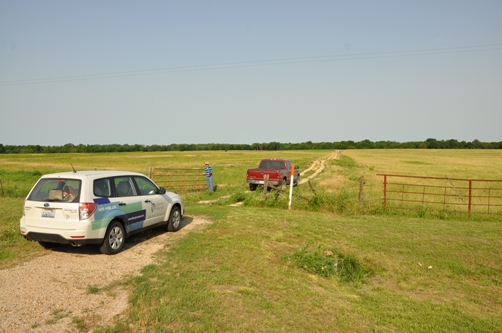
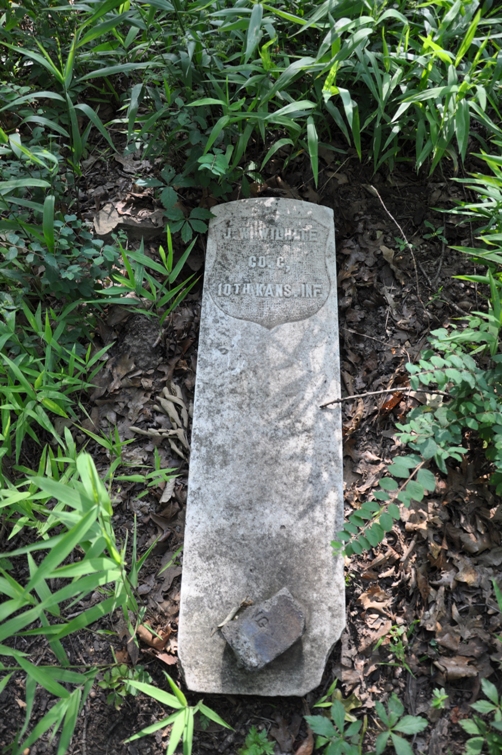
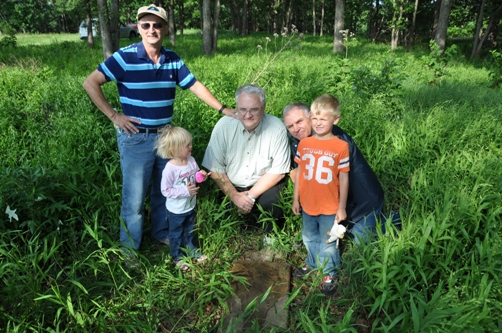
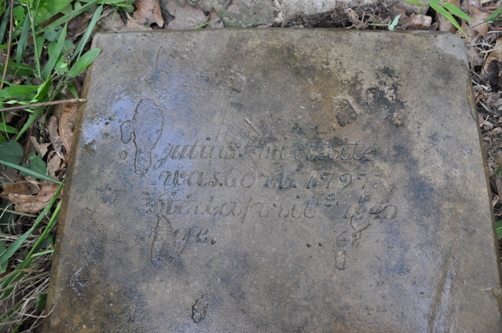
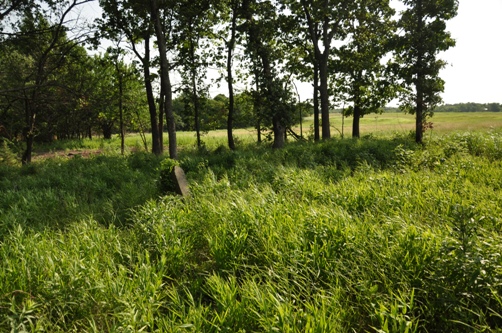
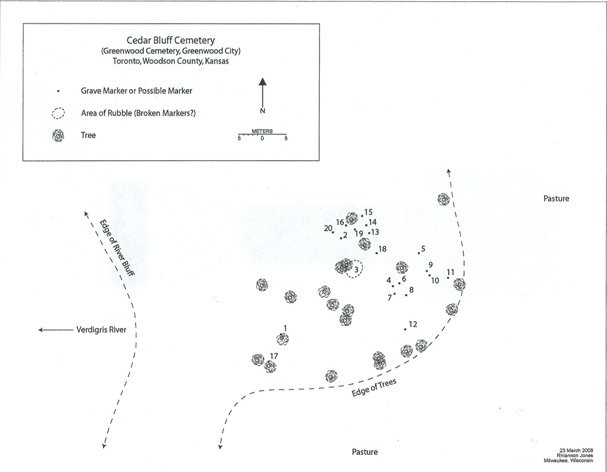
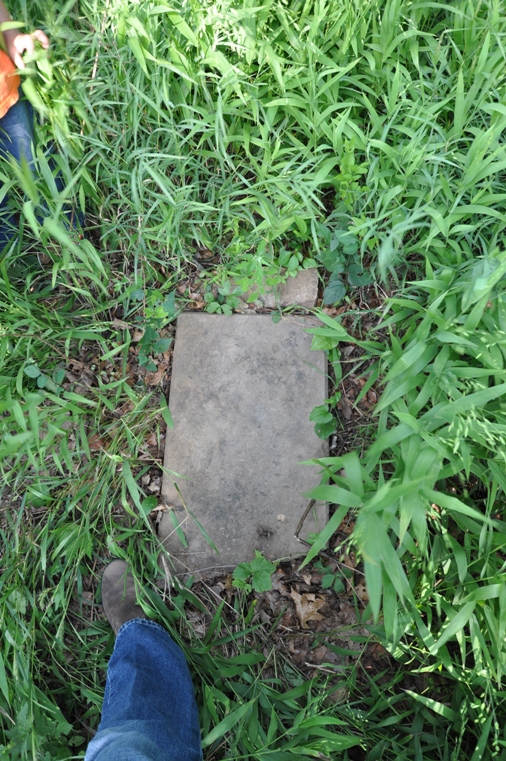
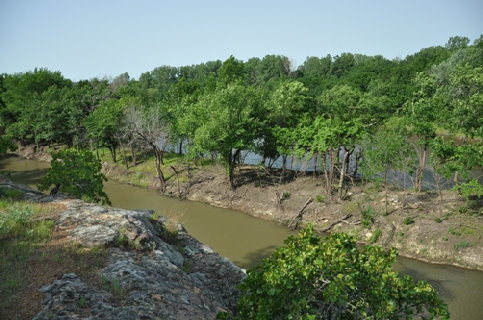
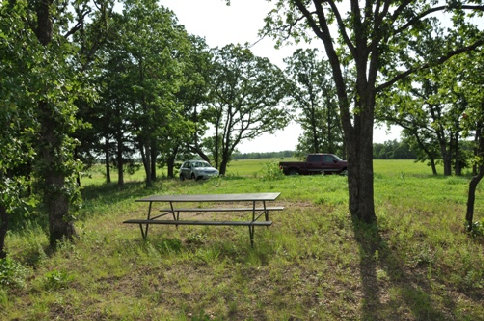
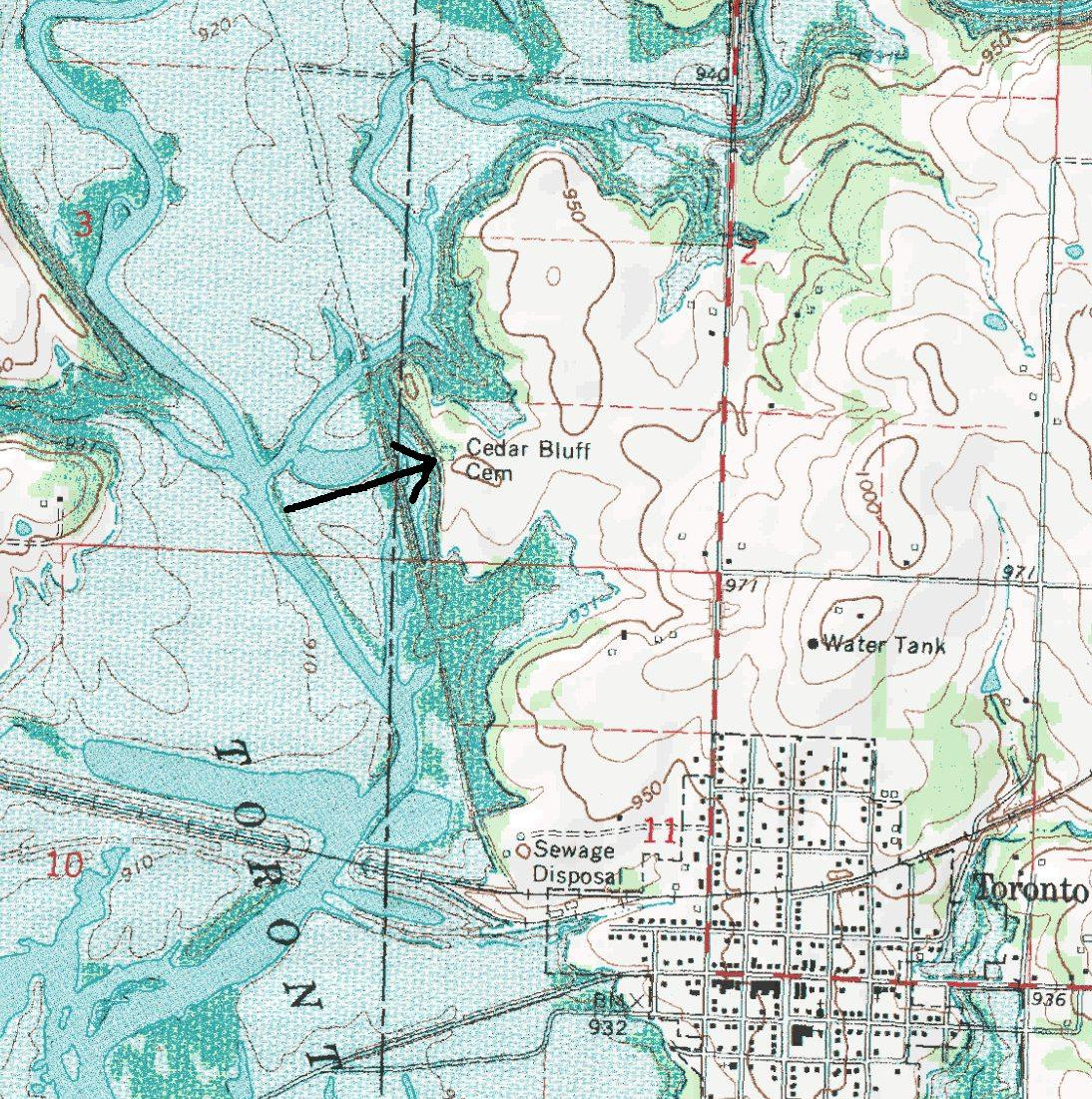
Above: Cedar Bluff Cemetery map by Rhiannon M. Jones. Below: USGS topo map of location of cemetery.
Picnic table at bluffs edge near the cemetery
View from the bluff with overflow pond and Verdigres River behind trees
Standing over Julius grave before we poured water on it
Some of the family with the grave
Julius Wilhite - was born 1797 - Died April 1860 - Age 63
J. W. Wilhite CO. C, 10th Kans. Inf (son of Julius Wilhite)
Here is the cemetery, overgrown and hidden
Private gate off highway 105, the cemetery is in the trees in the distance









